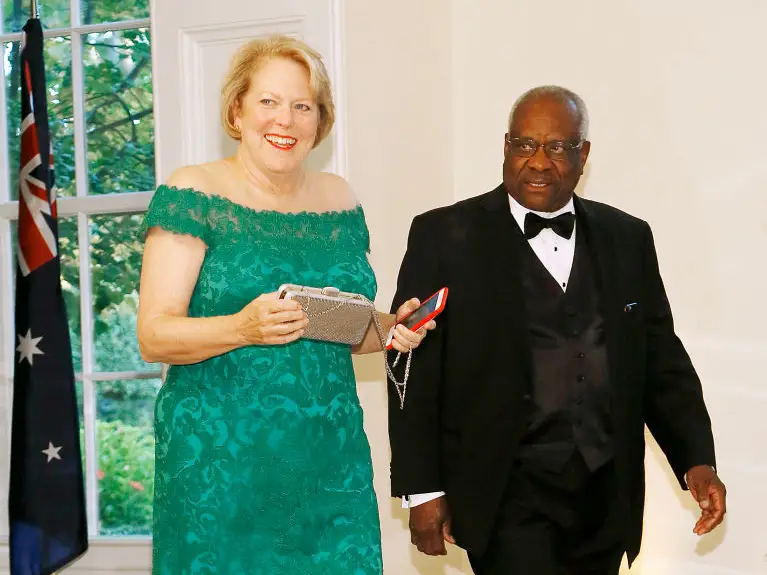By Rick Alan Ross
Recently a video from the 1980s of Ginni Thomas, wife of Supreme Court Justice Clarence Thomas, was released online. It features Thomas talking about her involvement in a cultic seminar-selling company called Lifespring, which was eventually sued out of existence. Thomas was one of the many victims of Lifespring.

Ginni and Clarence Thomas
Former cult member and author Steven Hassan apparently facilitated this support group and somehow had access to the 36-year-old video. He released the video on Twitter proclaiming, “I knew Ginni Thomas. Ginni Thomas was in a cult (the large group awareness training cult, Lifespring). Here she is in 1989 [actually 1986] speaking at an event I hosted for former members. Until today, almost NO one has seen this video.”
After releasing the video Hassan later speculated, “Sadly, the people who helped deprogram Ginni were also apparently involved in right-wing causes. As is the case with SO many former members, she was overly susceptible and went from one cult to another (The Cult of Trump),” [sic].
Thomas was reportedly “deprogrammed” by respected exit-counselor Kevin Garvey. Garvey, who passed away some years ago, never influenced Thomas to change her political views. Quoted in the Washington Post he simply said, “I got a phone call from her asking for help,” Garvey then met with Ginni Thomas (1984) for eight hours at a diner in Georgetown. And he “left feeling satisfied that the young woman would be all right.”
Kevin Garvey had no interest in Thomas’ political beliefs and consistent with his professional ethics, only focused on her concerns about Lifespring, and nothing else. And it must be noted that Steven Hassan has a troubled professional history of client complaints and was admonished by his licensing board for misconduct.
By way of historical background, Ginni Thomas grew up in Nebraska raised by Republican parents. Thomas herself is a lifelong Republican and supporter of conservative causes. Her politics were not changed either by Lifespring or her process of leaving Lifespring.
Before marrying Clarence Thomas (1987) and becoming involved in Lifespring, Ginni Thomas graduated law school (1983) and worked in Washington D.C. for Nebraska Republican Congressman Hal Daub (1981-1983). Later, she consistently continued her conservative commitment, which included opposing equal pay for women and later (2000) working at the Heritage Foundation, a conservative think-tank.
Many people disagree with Ginni Thomas’ politics, but that’s no excuse for using her pain and suffering through Lifespring to excoriate her.
Ginni Thomas’ was deceptively preyed upon and victimized by a destructive cult-like organization. This must not be used to shame or blame her in any way. A former cult member like Steven Hassan who says he empathizes with cult victims knows this. What is shameful is trading on Ginni Thomas’ personal history and suffering, shared intimately at a support group, and using it as “click bait” for self-promotion, because she is now trending in the news. And doing so is not only a betrayal of Ms. Thomas’ trust, but more importantly an ethical breach for any helping professional that claims to care about cult victims.
What is the message this video release sends about a notable public figure or anyone else for that matter, coming forward to share their personal experience?
Does it discourage or encourage others to come forward like Ginni Thomas?
Ginni Thomas wanted to help people. She said in the video, “I want to expose Lifespring, I want to keep other people from going through that experience.”
Is this the way we want to respond to someone who has suffered through such an experience and wanted to help others?
Does the release of this video encourage cult victims to come forward, either in an effort to help others and/or seeking solace and understanding through a support group, with people who can share about similar situations?
There is currently far too much politicizing of the word “cult.”
Today factions on the political right and left use the word “cult” as an invective to denigrate and demonize political opponents.
Now, with total disregard of the historical facts, Ginni Thomas is being shamed publicly and branded as “brainwashed,” despite the fact that her political beliefs were neither changed by Lifespring, nor by leaving Lifespring.
Finally, it may be sensational and garner attention, but Thomas’ sad experience with a cult-like group, before her marriage to Clarence Thomas, must not be politicized and cannot ethically be used as an indictment.
Exploiting the painful “cult” experience of Ginni Thomas is wrong.
Note: Destructive cults have been similarly defined by cult experts historically over the years. Frequently these definitions intersect on three primary core characteristics that form the nucleus for the definition of a destructive cult. These three criteria were first established by psychiatrist and author Robert Jay Lifton when he published his findings (1981) at Harvard University in a paper titled “Cult Formation.” These three core characteristics are (1) The single most salient feature of a destructive cult is an absolute authoritarian and totalitarian leader, often charismatic, who becomes an object of worship and is the defining element and driving force of the group. (2) The leader and group use coercive persuasion and thought reform techniques to gain undue influence over group members. (3) Having gained undue influence the leader and group manipulate the members to exploit them and do harm. This varies by degree from group to group, with some groups being much more destructive than others.




Great points, thanks for writing this up.